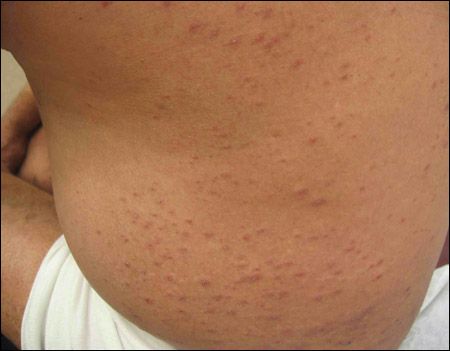- Clinical Technology
- Adult Immunization
- Hepatology
- Pediatric Immunization
- Screening
- Psychiatry
- Allergy
- Women's Health
- Cardiology
- Pediatrics
- Dermatology
- Endocrinology
- Pain Management
- Gastroenterology
- Infectious Disease
- Obesity Medicine
- Rheumatology
- Nephrology
- Neurology
- Pulmonology
Eosinophilic Pustular Folliculitis
These pruritic pustules had appeared on the lower back of a 45-year-old white man and progressively spread to the entire back over a month. He had recently completed chemotherapy for chronic lymphocytic leukemia. Results of HIV testing were negative.

These pruritic pustules had appeared on the lower back of a 45-year-old white man and progressively spread to the entire back over a month. He had recently completed chemotherapy for chronic lymphocytic leukemia. Results of HIV testing were negative.
The patient's rash is characteristic of eosinophilic pustular folliculitis. This rare dermatosis of unknown cause was initially reported by Ise and Ofuji1; thus, the majority of case reports are from Japan. The average age at presentation is 30 years. The condition is about 5 times more common in men than in women. Clinically, patients have repeated episodes of intensely pruritic papulopustules on the face, back, and upper extremities that usually last 7 to 10 days and recur every 3 to 4 weeks. Histological examination reveals spongiosis, infundibular eosinophilic pustules, and a dermal infiltrate of eosinophils.2
Eosinophilic pustular folliculitis is classically considered idiopathic. However, variants have occurred in patients with systemic diseases, such as AIDS (in patients with CD4+ cell counts less than 300/μL) and chronic lymphocytic leukemia, and in infants-in whom the rash primarily involves the scalp and lacks grouping of the papulopustules.3 Medications associated with eosinophilic pustular folliculitis include minocycline, carbamazepine, allopurinol, indeloxazine hydrochloride, and possibly cyclophosphamide.
The proposed mechanism in chronic lymphocytic leukemia (not associated with chemotherapy) is clonal expansion of B cells that produce interleukin-5 and thereby stimulate eosinophils.4 Eosinophilic pustular folliculitis related to chemotherapy typically occurs about 7 days after treatment.5
Treatment of eosinophilic pustular folliculitis generally consists of topical therapies, including corticosteroids, UVB phototherapy, psoralen-UVA, and indomethacin-which was used in this patient. Unfortunately, he was lost to follow-up.
References:
REFERENCES:
1.
Ofuji S, Ogino A, Horio T, et al. Eosinophilic pustular folliculitis.
Acta Derm Venereol
. 1970;50:195-203.
2.
Teraki Y, Konohana I, Shiohara T, et al. Eosinophilic pustular folliculitis (Ofuji's disease). Immunohistochemical analysis.
Arch Dermatol
. 1993;129:1015-1019.
3.
Agnew KL, Ruchlemer R, Catovsky D, et al. Cutaneous findings in chronic lymphocytic leukaemia.
Br J Dermatol
. 2004;150:1129-1135.
4.
Lambert J, Berneman Z, Dockx P, et al. Eosinophilic pustular folliculitis and B-cell chronic lymphatic leukaemia.
Dermatology
. 1994;189(suppl 2):58-59.
5.
Laing ME, Laing TA, Mulligan NJ, Keane FM. Eosinophilic pustular folliculitis induced by chemotherapy.
J Am Acad Dermatol
. 2006;54:729-730.
Common Side Effects of Antiretroviral Therapy in HIV Infection
February 7th 2013What are some of the more common side effects of antiretroviral therapy, and what can the primary care physician do to help manage these effects? In this podcast, infectious disease expert Rodger MacArthur, MD, offers insights and points readers to updated comprehensive guidelines.
